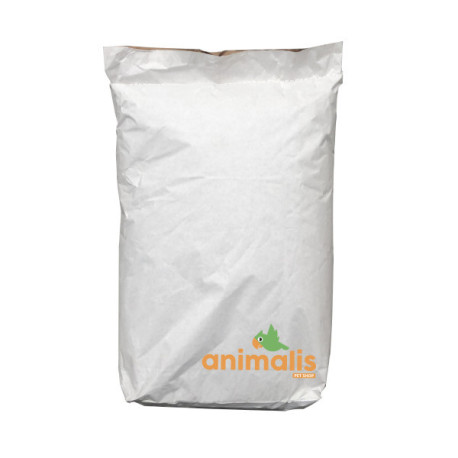





Reference: MILLETJAPONAIS15KG
Japanese millets (often called Echinochloa esculenta or Japanese millet) are small ancient grains traditionally cultivated in Asia, appreciated both for human consumption and as seeds for birds and poultry.
Description:
Appearance: small round seeds, smooth, ranging from pale yellow to golden brown.
Size: approximately 1.5–2 mm.
Taste: mild, slightly sweet, and floury.
Composition: rich in complex carbohydrates, proteins (10–12%), fibers, vitamins (B1, B2, niacin), and minerals (magnesium, iron, phosphorus, manganese).
Naturally gluten-free.
Japanese millets (often called Echinochloa esculenta or Japanese millet) are small ancient grains traditionally cultivated in Asia, appreciated both for human consumption and as bird and poultry seed.
Description:
Appearance: small round, smooth seeds, pale yellow to golden brown in color.
Size: about 1.5–2 mm.
Taste: mild, slightly sweet and floury.
Composition: rich in complex carbohydrates, proteins (10–12%), fibers, vitamins (B1, B2, niacin), and minerals (magnesium, iron, phosphorus, manganese).
Naturally gluten-free.
Main properties:
Energy source:
Provides slow-release carbohydrates → progressive and long-lasting energy.
An interesting food for athletes and active people.
Gentle digestion:
Light fibers promote intestinal transit.
Alternative for those sensitive to gluten.
Bone and nerve health:
Rich in magnesium and phosphorus, useful for bone strength and muscle/nerve relaxation.
Metabolic balance:
B vitamins contribute to energy production and proper functioning of the nervous system.
Alkalizing effect:
Unlike some acidifying grains, millet helps maintain a good acid-base balance.
Niger seed is a bird seed rich in phosphorus and calcium.
Niger seeds (or nyjer seeds) are fine seeds rich in oil.
They come from Guizotia abyssinica (also called Oleiferous Guizotia).
Niger is very popular with most birds, goldfinches and tarins love it.
Niger is one of the few bird seeds with a good calcium/phosphorus ratio.
Niger, birdseed rich in phosphorus and calcium. Niger seeds (or nyjer seeds) are fine seeds rich in oil. They come from Guizotia abyssinica (also known as Guizotia oleiferous). The niger is highly prized by most birds, goldfinches and siskins love it.
The seed is mainly grown in India, Burma, Ethiopia and Nepal. Niger is an oilseed with a high fat content (38-43%) and protein content (23%). It provides quality food for all species of wild and forest birds, both in dry and sprouted form.
Niger is one of the few birdseeds with a good ratio of calcium to phosphorus.
Hemp seeds are highly nutritious and contain more essential fatty acids (EFAs) than any other source and are in second place, after soya, for their richness in highly digestible proteins, of high biological value. They are particularly recommended during the breeding seasons in order to stimulate the reproductive instinct of birds.
Onion seeds are rich in minerals, vitamins, and antioxidants.
Dari, also known as sorghum or millet, is a variety of grain that is related to millet varieties. Dari is the size of a hemp seed. The grain originates from the warm regions of Australia, Asia, Africa, and South America. There are three varieties: white dari, yellow dari, and reddish-brown dari. It is noteworthy that more value is attributed to light dari than to reddish-brown dari. Regarding nutritional value, there is not the slightest difference. Furthermore, reddish-brown dari is well appreciated by lovebirds. Dari can be compared to wheat in terms of starch content. The seed has a favourable composition of amino acids. The protein present in dari has a particularly high leucine content.
Canary seed is a grass, an annual plant that can reach up to 1m in height, with seeds found in the inflorescences. These seeds make up a significant portion of most bird seed mixes.
• Excellent for canaries, European and exotic birds, budgerigars, and large parakeets.
• EXTRA canary seeds have undergone additional cleaning and are of exceptional quality. Unique on the market!
This seed from switchgrass is rich in protein (12.6%) it also contains 60% carbohydrates and less than 5% fat.
It is the richest variety of millet in protein. Japanese millet is recommended to all breeders of exotics, natives, parakeets, large parakeets.
The flaxseed consists of 40 to 45% oil and 25% protein. Flaxseed preserves very well. It contains, in particular, two fatty acids with similar names (both derived from the word "lin"), linolenic acid (an omega-3) and linoleic acid.
The seed is used in animal feed, particularly for laying hens for which an increase in the omega-3 content of the eggs is desired.
Due to these properties, this seed aids digestion.
Paddy rice seed or raw rice which is perfect for exotic big-beaked birds such as padda and birds of Asian descent. This seed is also appreciated by parakeets, parrots and exotic doves.
The sunflower seed contains nearly 40% lipids, but also proteins, carbohydrates, and vitamins B and E. A sunflower seed contains approximately 600 kilocalories per 100 g.
It meets the needs of a wide variety of birds throughout the year, including the smallest among them.
Sunflower seeds are a real treat for our birds who love them!
They have the property of binding to minerals such as calcium, iron and zinc and making them less bioavailable.

Japanese millets (often called Echinochloa esculenta or Japanese millet) are small ancient grains traditionally cultivated in Asia, appreciated both for human consumption and as seeds for birds and poultry.
Description:
Appearance: small round seeds, smooth, ranging from pale yellow to golden brown.
Size: approximately 1.5–2 mm.
Taste: mild, slightly sweet, and floury.
Composition: rich in complex carbohydrates, proteins (10–12%), fibers, vitamins (B1, B2, niacin), and minerals (magnesium, iron, phosphorus, manganese).
Naturally gluten-free.
